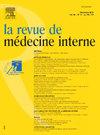[住院医师培训计划改革7年后内科和临床免疫学实习地点的评估:来自法国2024年年底调查的结果]。
IF 0.9
4区 医学
Q3 MEDICINE, GENERAL & INTERNAL
引用次数: 0
摘要
目的:编制一份法国内科和临床免疫学(DES-MIIC)住院医师培训计划[Diplôme d'Études spsamcialissames]批准的培训地点清单。方法:联系了所有地方协调员,在其地理分区内建立了经批准的综合医疗信息系统和综合医疗信息系统实习地点名单。结果:获得批准的培训地点244个,其中87个(35.7%)在大学附属医院。核可的训练场址数目视区域/分而定,差别很大。大学医院内外实习地点分别占85%(74/87)和63.7%(100/157),占94.3%(82/87)和84.1%(132/157),占80.5%(70/87)和52.2%(82/157)。大学医院的选拔空缺率低于综合医院,核心阶段、发展阶段和巩固阶段的空缺率分别为1.5(89.3%对61%)、1.8(88.8%对48.9%)和1.6(88.5%对55.4%)。结论:35%的实习地点位于大学附属医院。经核准的DES-MIIC培训地点数目视区域/细分而定,差别很大。一半的实习职位空缺在大学医院之外,正如这些医院近一半的培训地点缺乏“整合阶段”的批准一样。本文章由计算机程序翻译,如有差异,请以英文原文为准。
Enquête sur les terrains de stage du diplôme d’études spécialisées (DES) de Médecine interne et Immunologie clinique : état des lieux fin 2024, sept ans après la mise en place de la réforme du troisième cycle des études médicales en France
Objective
To compile a list of approved training sites for the Residency Training Program [Diplôme d’Études Spécialisées] in Internal Medicine and Clinical Immunology (DES-MIIC) in France.
Method
All local coordinators of the DES-MIIC were contacted to establish the list of approved internship sites for the MIIC DES within their geographical subdivision.
Results
We listed 244 approved training sites, of which 87 (35.7%) were in university hospitals. Depending on the region/subdivision, the number of approved training sites varied significantly. Internship sites within and outside of university hospitals were approved for the core-phase in 85% (74/87) and 63.7% (100/157) of cases, for the “development phase” in 94.3% (82/87) and 84.1% (132/157) of cases and for the consolidation phase 80.5% (70/87) and 52.2% (82/157) of cases, respectively. The vacancy rate for selection was lower in university hospitals than in general hospitals with ratios of 1.5 (89.3% vs. 61%), 1.8 (88.8% vs. 48.9%) and 1.6 (88,5% vs. 55.4%) - for respectively the core, development and consolidation phases.
Conclusion
Thirty-five percent of internship sites were located in University hospitals. Depending on the region/subdivision, the number of approved training sites for the DES-MIIC varies greatly. Half of internship positions are vacant outside of University hospitals, just as nearly half of training sites in these same hospitals lack approval for the “consolidation phase”.
求助全文
通过发布文献求助,成功后即可免费获取论文全文。
去求助
来源期刊

Revue De Medecine Interne
医学-医学:内科
CiteScore
0.70
自引率
11.10%
发文量
526
审稿时长
37 days
期刊介绍:
Official journal of the SNFMI, La revue de medecine interne is indexed in the most prestigious databases. It is the most efficient French language journal available for internal medicine specialists who want to expand their knowledge and skills beyond their own discipline. It is also the main French language international medium for French research works. The journal publishes each month editorials, original articles, review articles, short communications, etc. These articles address the fundamental and innumerable facets of internal medicine, spanning all medical specialties. Manuscripts may be submitted in French or in English.
La revue de medecine interne also includes additional issues publishing the proceedings of the two annual French meetings of internal medicine (June and December), as well as thematic issues.
 求助内容:
求助内容: 应助结果提醒方式:
应助结果提醒方式:


